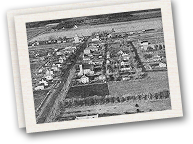A Brief History of Sperling
Early Settlers
Sperling's roots go back to about 1880 when the Canadian and Manitoba governments were encouraging the settlement of the prairies. Under the Dominion Lands Act of 1872 the government provided 160 acres (a quarter section) of free land to each head of a family or 21 year-old male if he paid a $10 registration fee, resided on the land for three years, cultivated 30 acres and built a permanent dwelling. Much other land was for sale, having been granted originally to the railways and others, then purchased and resold by speculators and land agents.
Boyne Marsh
Most of the land around Sperling, to the north, south, and east, was part of the Boyne Marsh. The Boyne River and Tobacco Creek flowed into this area from the west, and the Morris (or Scratching) River flowed out to the east. The marsh made for good hay and pasture, but was not reliable for growing wheat.
Adam Waddell family
One of the early families who settled in the non-marshy area just to the west of Sperling was the Adam Waddell family. His son Thomas led the exodus from near Mount Forest, Ontario in 1879, homesteading on SW36-6-3W – about 3 miles northwest of present-day Sperling. Adam and the rest of his family followed in 1881, and homesteaded NE26-6-3W. Scottish-born, Adam had immigrated to Canada in about 1832. Four other sons established themselves on nearby farms; the daughters married other settlers.
Other Pioneers
Other pioneer settlers to arrive in that area in the next decade or so included the Bates and Garnett families. John Bates had a post office on NE28-6-3W, which served the area from 1891 to 1912. Garnett School was established in 1884 on SW34-6-3W.
R.B. Waddell (a nephew of Adam) and his three sons (and six daughters) settled in the area in the late 1890's. Other nephews of Adam were four brothers who settled in the area in the same time frame. One of them, R.H. Waddell, played a major role as an early real estate developer of Sperling.
The Big Ditch
Starting in 1898, a plan was launched to construct drains through the Boyne Marsh. These included what became locally known as "the big ditch" running west to east along the boundary between the municipalities of Morris and Macdonald, the Norquay channel three miles north, and several others to the south. The rate of settling onto farms accelerated from this time, primarily by families from Ontario, and later from the USA and elsewhere.
Settlers from Ontario
Egremont Township, northwest of Toronto, was the source of many early settlers in addition to the Waddells. Family names from Egremont included: Peckover, Curdt, Mogk, Nichol, Wilson, Lester, Galbraith, and Sessions. Other southern Ontario names included: Ferris, Barry, Hamilton, Young, Rehill, Skeavington, Davison, Smith, Webster, Hooper, MacLean, Burnett, Tanner, McKee, Davidson, Dales, Hobbs, and Snider. Most of these families were of British and Scottish heritage. Direct-from England families included Dracass, Last, and Holmes.

